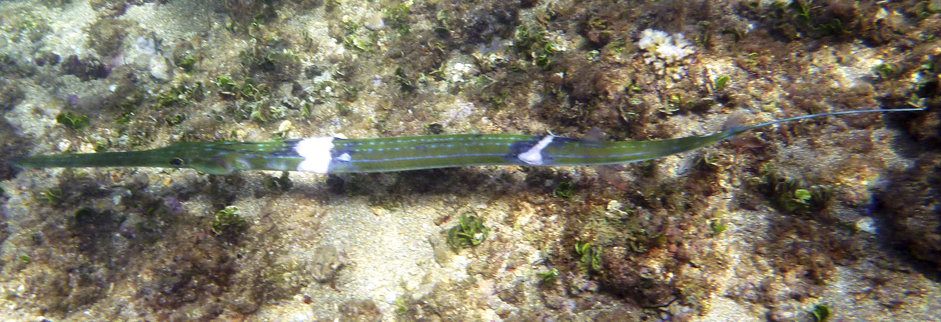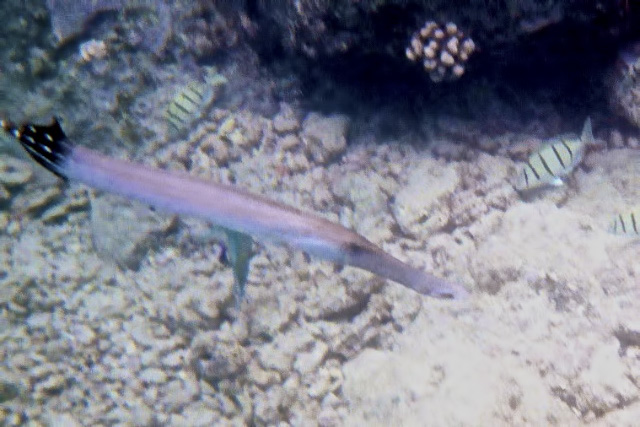Published in the Ocean Watch column, Honolulu Star-Advertiser © Susan Scott
Monday, October 15, 2012

A cornetfish.
My husband, Craig, came in from snorkeling the other day with news. “I saw a school of baby trumpetfish, about 20 or 30 together.”
“You mean cornetfish?” I said. The similar-looking cornetfish fish are far more common on that reef.
“No,” he said. “They were trumpetfish.”
Craig had to leave for work, but he told me where to look. I donned mask and snorkel, and aha! I was right. A school of about 10, foot-long cornetfish (they grow to 54 inches) swam past.
But Craig was right, too. As I snorkeled along I found his larger school of foot-long trumpetfish (which grow to 27 inches) as he described them, sheltering under a coral ledge.
Unless you know what to look for, trumpetfish and cornetfish can be hard to tell apart. Both have long, skinny bodies with long cylindrical snouts ending in mouths that can suck up a live fish like a high-end Hoover. It’s from these expandable mouths that the fish got the names of brass horns.

Cornetfish. The white marks are bite marks. Susan Scott
Some people call them pipefish but that refers to another family. Pipefish look like stretched-out sea horses. Still, the pipefish label isn’t far off because all of the above are close relatives. The families including trumpetfish, cornetfish, sea horses and pipefish are grouped in the same scientific order, Syngnathiformes.
That’s a mouthful, but the word’s English meaning is easy to pronounce and describes the group aptly: tube-mouthed fish. To distinguish a cornetfish from a trumpetfish, though, look at the other end. A cornetfish has a long whiplike filament trailing from the tail fin; a trumpetfish tail looks like a broom with a stubby handle.
Hawaii hosts one species each of trumpetfish and cornetfish, but since they change the shade and direction of their stripes, as well as their body color, to suit their camouflage purposes, it seems as if we have more.

Trumpetfish- Hanauma Bay. Scott Davis
Both are crackerjack stalkers, hanging vertically in the water to mimic a stick, and changing colors and patterns to match anything from tangs to turtles and even lobsters to get close to their prey.
It’s amusing to see a long, thin fish swimming in the middle of a bunch of round, fat fish, as if it were one of them. To the prey, though, this is no laughing matter. Tube-mouths inhale mightily.
These big fish have their own predator problems. The white marks on the cornetfish pictured here are bite wounds, perhaps inflicted by one of the many barracudas I see on that reef. Amazingly, the 3-foot-long cornetfish swam and behaved normally. I hope the schools of baby trumpetfish Craig and I saw last week are as lucky.
©2012 Susan Scott